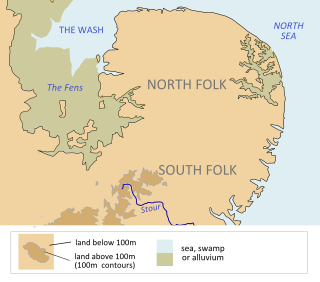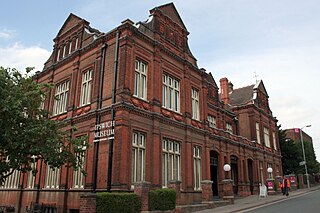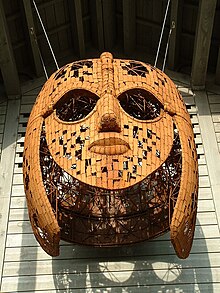
Rædwald, also written as Raedwald or Redwald, was a king of East Anglia, an Anglo-Saxon kingdom which included the present-day English counties of Norfolk and Suffolk. He was the son of Tytila of East Anglia and a member of the Wuffingas dynasty, who were the first kings of the East Angles. Details about Rædwald's reign are scarce, primarily because the Viking invasions of the 9th century destroyed the monasteries in East Anglia where many documents would have been kept. Rædwald reigned from about 599 until his death around 624, initially under the overlordship of Æthelberht of Kent. In 616, as a result of fighting the Battle of the River Idle and defeating Æthelfrith of Northumbria, he was able to install Edwin, who was acquiescent to his authority, as the new king of Northumbria. During the battle, both Æthelfrith and Rædwald's son, Rægenhere, were killed.

Suffolk is a ceremonial county of England in East Anglia. It borders Norfolk to the north, Cambridgeshire to the west and Essex to the south; the North Sea lies to the east. The county town is Ipswich; other important towns include Lowestoft, Bury St Edmunds, Newmarket, and Felixstowe which has one of the largest container ports in Europe.

Woodbridge is a port town and civil parish in the East Suffolk district of Suffolk, England. It is 8 miles (13 km) up the River Deben from the sea. It lies 7 miles (11 km) north-east of Ipswich and forms part of the wider Ipswich built-up area and is close to Kesgrave.

Sutton Hoo is the site of two early medieval cemeteries dating from the 6th to 7th centuries near the English town of Woodbridge. Archaeologists have been excavating the area since 1938, when a previously undisturbed ship burial containing a wealth of Anglo-Saxon artefacts was discovered. The site is important in establishing the history of the Anglo-Saxon kingdom of East Anglia as well as illuminating the Anglo-Saxons during a period which lacks historical documentation.

The Wuffingas, Uffingas or Wiffings were the ruling dynasty of East Anglia, the long-lived Anglo-Saxon kingdom which today includes the English counties of Norfolk and Suffolk. The Wuffingas took their name from Wuffa, an early East Anglian king. Nothing is known of the members of the dynasty before Rædwald, who ruled from about 599 to c.624. The Viking invasions of the 9th century and Dissolution of the monasteries in the 16th century both led to the destruction of documents relating to the rule of the Wuffingas.

Ipswich Museum is a registered museum of culture, history and natural heritage located on High Street in Ipswich, the county town of Suffolk. It was historically the leading regional museum in Suffolk, housing collections drawn from both the former counties of East Suffolk and West Suffolk, which were amalgamated in 1974.

Rendlesham is a village and civil parish near Woodbridge, Suffolk, United Kingdom. It was a royal centre of authority for the king of the East Angles, of the Wuffinga line; the proximity of the Sutton Hoo ship burial may indicate a connection between Sutton Hoo and the East Anglian royal house. Swithhelm, son of Seaxbald, who reigned from 660 to around 664, was baptised at Rendlesham by Saint Cedd with King Æthelwold of East Anglia acting as his godfather. He died around the time of the great plague of 664 and may have been buried at the palace of Rendlesham.
Wehha of East Anglia is listed by Anglo-Saxon records as a king of the East Angles. If he existed, Wehha ruled the East Angles as a pagan king during the 6th century, at the time the region was being established as a kingdom by migrants arriving from what is now Frisia and the southern Jutland peninsula. Early sources identify him as a member of the Wuffingas dynasty, which was established around the east coast of Suffolk. Nothing of his reign is known.
Basil John Wait Brown was an English archaeologist and astronomer. Self-taught, he discovered and excavated a 6th-century Anglo-Saxon ship burial at Sutton Hoo in 1939, which has come to be called "one of the most important archaeological discoveries of all time". Although Brown was described as an amateur archaeologist, his career as a paid excavation employee for a provincial museum spanned more than thirty years.

The Dig is a historical novel by John Preston, published in May 2007, set in the context of the 1939 Anglo-Saxon ship burial excavation at Sutton Hoo, Suffolk, England. The dust jacket describes it as "a brilliantly realized account of the most famous archaeological dig in Britain in modern times".

The Kingdom of the East Angles, today known as the Kingdom of East Anglia, was a small independent kingdom of the Angles comprising what are now the English counties of Norfolk and Suffolk and perhaps the eastern part of the Fens. The kingdom formed in the 6th century in the wake of the Anglo-Saxon settlement of Britain. It was ruled by the Wuffingas dynasty in the 7th and 8th centuries, but fell to Mercia in 794, and was conquered by the Danes in 869, to form part of the Danelaw. It was conquered by Edward the Elder and incorporated into the Kingdom of England in 918.
Edith May Pretty was an English landowner on whose land the Sutton Hoo ship burial was discovered after she hired Basil Brown, a local excavator and amateur archeologist, to find out if anything lay beneath the mounds on her property.

The Sutton Hoo helmet is a decorated Anglo-Saxon helmet found during a 1939 excavation of the Sutton Hoo ship-burial. It was buried around the years c. 620–625 CE and is widely associated with an Anglo-Saxon leader, King Rædwald of East Anglia; its elaborate decoration may have given it a secondary function akin to a crown. The helmet was both a functional piece of armour that would have offered considerable protection if ever used in warfare, and a decorative, prestigious piece of extravagant metalwork. An iconic object from an archaeological find hailed as the "British Tutankhamen", it has become a symbol of the Early Middle Ages, "of Archaeology in general", and of England.
Sutton is a village and a civil parish on the B1083 road, in the East Suffolk district, in the county of Suffolk, England. Sutton has a pub, a mobile post office and a place of worship. There is also the hamlet of Sutton Street and the Sutton Common estate nearby.
Claudia Böse is an abstract painter and has been based in Suffolk, England, since 2002. Böse graduated from the Royal Academy of Arts in 1996 and is a member of the artists network Kunstnetz International. Her work has been exhibited in London, Oxford, Birmingham, Manchester, Berlin, Neukölln, Freiburg, Valparaiso and Miami. Her work has been acquired by Abbot Hall Art Gallery, Hamburger Universität für Wirtschaft und Politik, The Priseman Seabrook Collection and the University of Oxford.

Herbert James Maryon was an English sculptor, conservator, goldsmith, archaeologist and authority on ancient metalwork. Maryon practiced and taught sculpture until retiring in 1939, then worked as a conservator with the British Museum from 1944 to 1961. He is best known for his work on the Sutton Hoo ship-burial, which led to his appointment as an Officer of the Order of the British Empire.

Peter Charles van Geersdaele was an English conservator best known for his work on the Sutton Hoo ship-burial. Among other work he oversaw the creation of a plaster cast of the ship impression, from which a fibreglass replica of the ship was formed. He later helped mould an impression of the Graveney boat, in addition to other excavation and restoration work.

Tranmer House is a country house in Sutton Hoo, Woodbridge, Suffolk, England, dating from 1910. The house is located on the Sutton Hoo Anglo-Saxon burial site, and in 1938 was the home of Edith Pretty. In June 1938, Pretty employed Basil Brown to undertake the excavation of a range of burial mounds on the estate, leading to Brown's discovery in May 1939 of a ship burial, "one of the most important archaeological discoveries of all time". The house is now owned by the National Trust.
Vincent Burrough Redstone was a Suffolk historian who suggested to Edith Pretty that the Sutton Hoo Ship-burial should be excavated. He was a master of Woodbridge School and secretary of the Suffolk Institute of Archaeology. He retired from Woodbridge School in 1921 and spent the remainder of his life researching historical topics. He was particularly noted for his study of Huguenot settlement in Suffolk.















